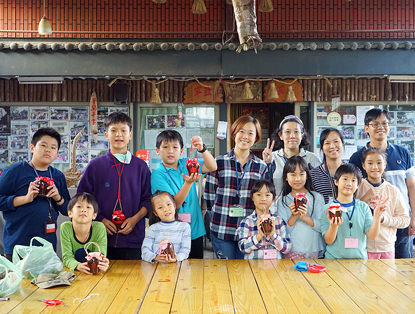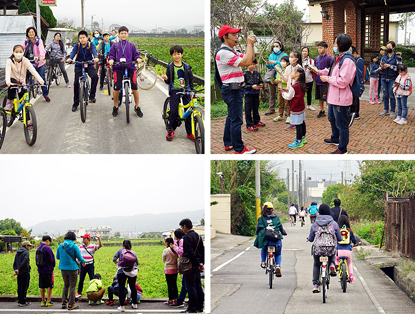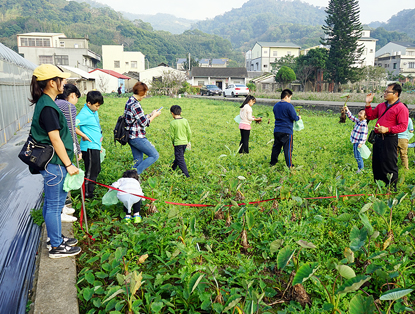Sketch of Archilife Study Tour, January 2019
|
2019年1月份見識之旅縮影  1月份見識之旅活動,於2019年1月12日由呂明澐小姐帶領13位祐生見習生及家長們,進行苗栗黃金小鎮芋見幸福暨客家文化之旅。活動開始之初,領隊呂明澐小姐提醒本次活動注意事項及觀察重點,先行建立見習生的背景知識。 1月份見識之旅活動,於2019年1月12日由呂明澐小姐帶領13位祐生見習生及家長們,進行苗栗黃金小鎮芋見幸福暨客家文化之旅。活動開始之初,領隊呂明澐小姐提醒本次活動注意事項及觀察重點,先行建立見習生的背景知識。For the study tour of January 12, 2019, Ms. Lu Ming-yun led 13 ARF interns and their parents on a tour to learn about taro and Hakka culture in Golden Town, Miaoli. At the start of the day's activities, team leader Ms. Lu Ming-yun reminded everyone about things to note and what to observe, and provided the interns some general background knowledge.  本次行程以黃金小鎮休閒農業區為主軸,由社區發展協會幹事擔任導覽人員。行程一開始,導覽人員解釋每年5至7月,道路兩旁的阿勃勒花朵盛開,黃燦燦的花串隨風搖曳,加上田間稻浪,一眼望去片片金黃,即「黃金小鎮」名稱由來。隨後簡單介紹該農業區涵蓋的範圍、地理環境、特色產業及主要作物,說明當地氣候與水質、土壤適合農作物生長,尤其適合種植紅棗,是全台唯一紅棗產地,也因生產多種農產品,一年四季各有景觀。緊接著,眾人跟隨導覽人員騎乘腳踏車,順著鐵馬道進行田園水圳生態巡禮,探索客家文化與農村風光。 本次行程以黃金小鎮休閒農業區為主軸,由社區發展協會幹事擔任導覽人員。行程一開始,導覽人員解釋每年5至7月,道路兩旁的阿勃勒花朵盛開,黃燦燦的花串隨風搖曳,加上田間稻浪,一眼望去片片金黃,即「黃金小鎮」名稱由來。隨後簡單介紹該農業區涵蓋的範圍、地理環境、特色產業及主要作物,說明當地氣候與水質、土壤適合農作物生長,尤其適合種植紅棗,是全台唯一紅棗產地,也因生產多種農產品,一年四季各有景觀。緊接著,眾人跟隨導覽人員騎乘腳踏車,順著鐵馬道進行田園水圳生態巡禮,探索客家文化與農村風光。Focusing on the Golden Town Leisure Agricultural Area, the tour was guided by a committee member of the community development association. The tour guide began by explaining that the Golden Town owes its name to the vast sea of golden yellow created by the vibrant clusters of golden shower flowers that bloom from May to July every year and the undulating yellow rice paddies. He then introduced the extent of the agricultural area, its geographical environment, specialty industries and main crops, explaining that local climate, water quality and soil are suitable for growing crops, especially red dates, and it is the only place in Taiwan that produces red dates. It also produces many types of farm products, offering a variety of landscapes all year round. What followed was a bicycle trip around the agricultural area to discover Hakka culture and farm scenery.  中午飯後,導覽人員講述苗栗公館係全台第二大的芋頭產區,僅次於屏東地區,然早期生產的檳榔心芋頭被盤商收購後,多以台中大甲芋頭之名販售,許多人並不知曉公館芋頭,遂透過產業結合休閒觀光,期盼讓更多人認識在地芋頭。接著導覽老師介紹客家料理重要的食材「福菜」,說明其係由芥菜醃漬成酸菜後,撕成長條狀抹鹽日曬,在還帶有水份時,緊密擠入玻璃瓶或甕中,再密封放置3至6個月;梅干菜則是把製做福菜剩餘的菜葉部分繼續日曬至全乾,能保存更久。隨後進行擠福菜體驗,眾人利用圓木棒將曬至6至7分乾的酸菜緊密擠入甕內,甕內儘量不留空氣,把多餘水分倒出後密封即可。 中午飯後,導覽人員講述苗栗公館係全台第二大的芋頭產區,僅次於屏東地區,然早期生產的檳榔心芋頭被盤商收購後,多以台中大甲芋頭之名販售,許多人並不知曉公館芋頭,遂透過產業結合休閒觀光,期盼讓更多人認識在地芋頭。接著導覽老師介紹客家料理重要的食材「福菜」,說明其係由芥菜醃漬成酸菜後,撕成長條狀抹鹽日曬,在還帶有水份時,緊密擠入玻璃瓶或甕中,再密封放置3至6個月;梅干菜則是把製做福菜剩餘的菜葉部分繼續日曬至全乾,能保存更久。隨後進行擠福菜體驗,眾人利用圓木棒將曬至6至7分乾的酸菜緊密擠入甕內,甕內儘量不留空氣,把多餘水分倒出後密封即可。After lunch, the tour guide said that Gongguan, Miaoli, is the second largest taro producing area after Pingdung in Taiwan. However, as the taros grown in the area were mostly sold as Dajia taro after purchase by wholesalers, many people have not heard of Gongguan taro. Through the combination of industry and recreational tourism, it is hoped that more people will learn about the local taros. The tour guide also introduced an important ingredient in Hakka pickle - "fucai", which is pickled mustard that is torn into long strips, salted and sun-dried, and sealed in a glass container or jar while still moist for three to six months. "Meigancai", on the other hand, is made by sun-drying the leaves left over from making "fucai" until completely dried for longer storage. Everyone then tried pressing pickled mustard that is 60-70% dried into a jar using a round-ended rod, squeezing out any air and pouring out excess water, and finally sealing the jar.  行程最後進行芋頭採摘活動,導覽人員先行對芋頭生態做解說,指出芋頭為一年生作物,7、8月時植株最高可達200公分,隨著秋天葉子枯萎,為供應球狀莖養分而逐漸縮短。教導眾人如何判斷是否成熟及採摘方法後,便開始拔芋頭,見習生皆是第一次親自下田採摘芋頭,個個不亦樂乎。至此,本日活動已近尾聲,大家一起合照留念後搭車返程,並期待於下次見識之旅再相見。 行程最後進行芋頭採摘活動,導覽人員先行對芋頭生態做解說,指出芋頭為一年生作物,7、8月時植株最高可達200公分,隨著秋天葉子枯萎,為供應球狀莖養分而逐漸縮短。教導眾人如何判斷是否成熟及採摘方法後,便開始拔芋頭,見習生皆是第一次親自下田採摘芋頭,個個不亦樂乎。至此,本日活動已近尾聲,大家一起合照留念後搭車返程,並期待於下次見識之旅再相見。The final part of the tour was taro picking. The tour guide explained that taro is an annual plant, growing up to 200 centimeters around July or August. Its leaves wilt and the plant becomes shorter in autumn as the nutrients are absorbed by its corm. Everyone was taught how to determine if the taro was ripe and how to harvest it. The interns enjoyed harvesting the taro as it was their first time. At this point, the day's itinerary came to an end. Everyone took a group photo before heading back and looked forward to the next study tour. |

